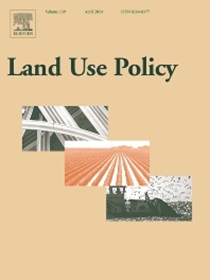Ambiguity in state-owned land property rights increases transaction costs in China’s transit-oriented development projects
IF 6
1区 社会学
Q1 ENVIRONMENTAL STUDIES
引用次数: 0
Abstract
This paper provides compelling evidence that the ambiguity in state-owned land property rights increases transaction costs in China’s transit-oriented development (TOD) projects. The constitution defines the state as the de jure (legally defined) owner of urban land, but tiers of local government share the de facto (practically controlled) land property rights; this ambiguity complicates land use right transfer for TOD. Through expert interviews, document analysis, and case studies in Guangzhou, we identified three critical issues. First, ambiguity in de facto land property rights has led district governments to relocate the metro depot site from a profitable plot suitable for metro scheduling and property development to land plots that are less advantageous and far away from the station. Second, the coexistence of land allocation and leasing approaches under state ownership discouraged an optimised land assembly for the TOD project. Rigid acquisition sizes designated in land allocation for infrastructure discouraged coordination and prolonged negotiations between the district government and the metro company. Finally, the district government faced a disproportionate fiscal responsibility compared to their land leasing share from the municipal government. They are thus passively against the TOD project using their land use planning power. These transaction costs delay the TOD project and jeopardise the outcomes, resulting in depots far from metro stations, housing adjacent to industrial areas, and oversized commercial spaces on urban fringes. We argue that the ambiguity in state-owned land property rights is rooted in China’s historical, cultural, and institutional contexts, driving high transaction costs for urban infrastructure development.
国有土地产权的模糊性增加了中国交通导向型开发项目的交易成本
本文提供了令人信服的证据,表明国有土地产权的模糊性增加了中国公交导向型开发项目的交易成本。宪法将国家定义为城市土地的法律上的所有者,但地方各级政府分享事实上的(实际控制的)土地产权;这种模糊性使TOD的土地使用权流转变得复杂。通过专家访谈、文献分析和广州的案例研究,我们确定了三个关键问题。首先,事实上土地产权的模糊性导致各区政府将地铁站址从适合地铁调度和房地产开发的有利可图地块搬迁到不太有利且远离车站的地块。其次,在国有所有制下,土地分配和租赁方式并存,阻碍了TOD项目的优化土地集合。在基础设施用地分配中,固定的收购规模阻碍了地方政府和地铁公司之间的协调和长期谈判。最后,与市政府出让土地的份额相比,区政府面临着不成比例的财政责任。因此,他们利用自己的土地使用规划权力,被动地反对TOD项目。这些交易成本延迟了TOD项目,并危及其成果,导致仓库远离地铁站,住宅毗邻工业区,以及城市边缘的超大商业空间。我们认为,国有土地产权的模糊性源于中国的历史、文化和制度背景,这导致了城市基础设施建设的高交易成本。
本文章由计算机程序翻译,如有差异,请以英文原文为准。
求助全文
约1分钟内获得全文
求助全文
来源期刊

Land Use Policy
ENVIRONMENTAL STUDIES-
CiteScore
13.70
自引率
8.50%
发文量
553
期刊介绍:
Land Use Policy is an international and interdisciplinary journal concerned with the social, economic, political, legal, physical and planning aspects of urban and rural land use.
Land Use Policy examines issues in geography, agriculture, forestry, irrigation, environmental conservation, housing, urban development and transport in both developed and developing countries through major refereed articles and shorter viewpoint pieces.
 求助内容:
求助内容: 应助结果提醒方式:
应助结果提醒方式:


